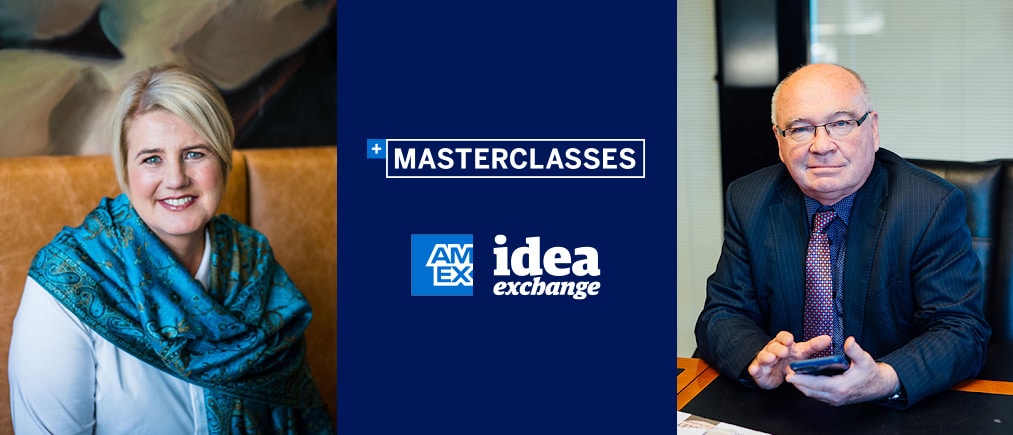Building Resilience During Blows to Business explored the importance of resilience to small businesses, whose recovery will be critical to the wellbeing of individuals, communities and our national economy. The health of a small business is often deeply dependent on the health of its owner, particularly with so many sole operators across Australia. As a result, personal resilience and mental wellbeing are key to ensuring a business survives – or, if it doesn’t, that its owner can begin again later.
Our speakers had in-depth experience in running small businesses, as well as supporting others to do the same:
- Leanne Faulkner, owner of Fortitude at Work and small business mental health advocate
- Peter Strong, CEO of the Council of Small Business Australia and former bookshop owner
Acknowledging that small business owners tend to be a practical bunch, Leanne and Peter pledged to focus on actionable steps for building a “resilience muscle”.
Know the warning signs that challenges may be taking a toll
Leanne and Peter agreed that one of the first steps to building resilience is being able to recognise red flags, like:
- Physical signs including poor sleep or muscle tension;
- Emotional changes, such as a shorter temper or regularly crying;
- Routinely missing important social or family events;
- Skipping physical exercise or self-care.
Both shared their personal experiences while running small businesses and the signs that helped them realise their resilience was low.
“As my previous business grew and grew, at one point I was under so much stress that I would find myself crying while driving to the office,” said Leanne. “That’s definitely the sort of sign that your resilience level is alarmingly low and needs some attention.”
For Peter, his major warning sign was a lack of sleep, saying that he would often just wake up in the middle of the night and worry.
However, they reiterated that acting on these warning signs shouldn’t mean stifling the emotions or fears that may be driving them. “Resilience isn’t necessarily about putting on a stiff upper lip and being positive all the time,” Leanne explained. “It’s the opposite. It’s recognising that sometimes life is painful and that you need space to contemplate a new normal and a way forward.”
“Once you recognise that perhaps it’s time to build your resilience muscle, it’s then time to think about ways to actually do that.”
Connect with others and find (or offer!) support
Many of the steps and responses to audience questions tied back to connection and togetherness.
This might mean ensuring you have a reliable confidante, or “wing person,” who can listen, allow you to talk through problems and even help you rehearse difficult conversations.
While your wing person can be anyone from a co-worker, friend or family member, Peter also spoke about the benefits of joining an industry association and connecting with peers.
“We booksellers have our own language, issues and suppliers. The same is true for other industries. Connect with those associations and you can find people who will advocate for you, who will understand what your issues are and will be able to communicate about them in a really helpful way.”
Responding to a question about what business owners can do to help one another, Peter and Leanne again highlighted the value of open communication and connection. Whether that’s seeking advice or support, ensuring we’re considerate about our asks from suppliers, or being transparent about challenges like cash flow, togetherness tends to make business challenges easier to manage.
“Talking and connecting are crucial,” said Leanne. “Yes, we hear it a lot, but it’s true – we’re in this together.”
Mindfulness: seeking out the space to respond
Leanne began her explanation of mindfulness by saying that the word often prompts groans, eye rolls or protestations that “meditation is too hard.”
“I’m not talking about meditation, though,” explained Leanne. “I’m talking about finding a gap – I usually call it ‘gap hunting’ – where we find the space between a stimulus and our response to it.
“A quick, easy way to find that space is to take a deep, deliberate breath and really think about how you’re going to respond.”
Peter and Leanne also discussed that mindfulness includes being aware of your mental wellbeing and taking strategic steps to manage it. The webinar included specific resources and tools for small business owners, including the Victorian Small Business Commission’s online mental health strategy and the My Business Health website mentioned in our previous masterclass.
For the full discussion and list of resources, access the masterclass replay.
Takeaways on business resilience
- Small business health tends to be directly tied to small business owner health, making resilience crucial in times of hardship.
- Resilience includes paying attention to how and when challenges are taking a toll, including physical symptoms, long-lasting changes in mood, increasing absences from important life events or regularly skipping exercise or self-care.
- Talk to a reliable confidante and join professional associations to connect with peers.
- Strive for mindfulness and allow yourself space to form productive responses or even grieve.
- Remember that togetherness – often in the form of greater communication and connection with others – tends to be the most potent way to improve both business performance and your own wellbeing.



